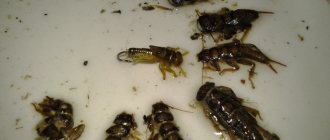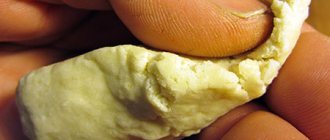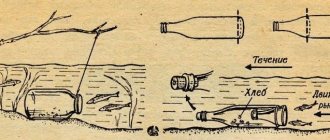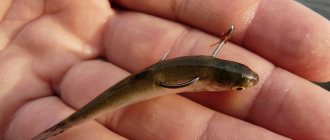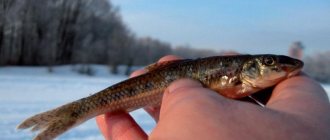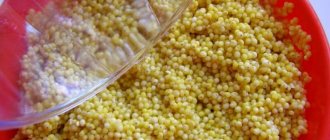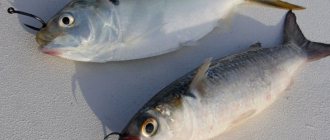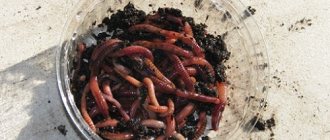☸ How to catch live bait in the fall
Catching live bait in the fall is much more difficult than in the summer, because as the water temperature drops, the “small population” of rivers and lakes leaves the coastal zone and moves to deeper areas. In other words, in the autumn there is little choice, which is a serious problem. The fact is that on each individual body of water, predators have their own preferences that have developed over many years. If the same pike is accustomed to eating verkhovkas and minnows, then it may not react at all to a small crucian carp, no matter how attractive it may be. That is why it is important to choose the right live bait, always the species that is found in the reservoir where you plan to fish. Better yet, catch it right on the spot.
Anglers use a wide variety of fish as live bait, from the nimble perch to the spiny ruff. Even decent-sized bream will do for catching deep-water pike and large catfish. We will discuss below where and how to get these fish, as well as other popular live baits.
Each type of fish has its own bait
As noted above, predators prefer miniature live bait (fry). For example, in winter pike prefers to eat fish no more than 10 cm long; pike perch, asp and catfish are not averse to profiting from such live bait. But in winter it is difficult to determine the location of these fish. To find them, sometimes you have to fish large areas of the reservoir. You can read the material about fishing with girders on the last ice.
But it is easier to detect another lover of live bait - perch, since it continues to be awake, it is not bothered by the lack of oxygen and the very low water temperature in the upper layers. Taking the fry with you, you can count on a decent perch catch. We recommend reading the article about fishing rods for winter fishing.
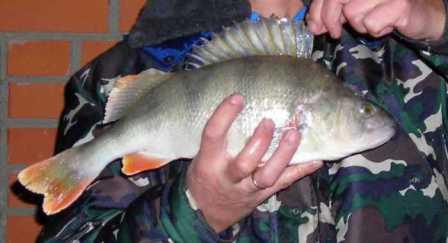
☸ Verkhovka
This miniature fish rarely exceeds 10 cm in length. It lives in almost all bodies of water, including closed ones and those located within the boundaries of a populated area. Moreover, in the latter, the concentration of verkhovka can be quite high, since there are usually few predators here, and there are more than enough people willing to feed the underwater inhabitants with bread. In the summer months, redfish are most often caught using a delicate bleak fishing rod, which breaks records in speed and efficiency, but in the fall this gear is less relevant.
With the arrival of the first cold weather, the verkhovka becomes sluggish, inactive, and stops responding to bait. To seduce her, you will have to put in a lot of effort: try a lot of baits, experiment with fishing depth, often change the place in search of a flock, and so on. Therefore, if fishing skill is not enough, it is better to use another method - a special net lift (other names - little fish, spider).
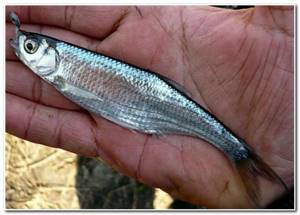
Unlike crucian carp or ruffe, verkhovka does not have good vitality, so it is stored for a relatively short time. It is better to keep it in a container intended for such purposes - a canna. To ensure that live bait remains truly alive, and not floating belly up on the surface, it is advisable to equip the eland with an aquarium aerator. It should be noted that some of the fish will die in any case, if not during storage, then during transportation. But there is no need to despair and rush to throw them away; dead fry can be useful for fishing with a line in the current.
Verkhovka is excellent for fishing for predators with bottom tackle or a float rod, which cannot be said about mugs. This is far from the best option, since this fish will not last long at depth. It is hooked onto the hook through the gills or by the lip, but in no case by the back. The slightest injury quickly puts her out of action.
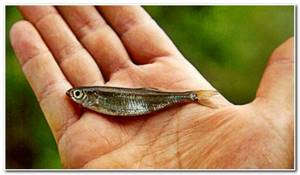
Fishing methods
Fishing for live bait in winter sometimes turns into another full-fledged fishing trip for zherlits. It is not always possible to catch a small fish so easily. But the success of going after a predator depends on this. Therefore, catching fry for live bait is the most important stage of preparation for departure. Methods and techniques for catching live bait in winter are selected depending on the conditions of the reservoir, the desires of the fisherman and local characteristics. Let's look at effective ways to catch live bait from the ice.
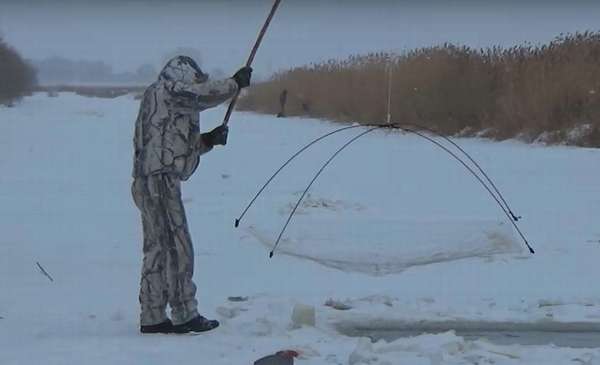
Lift
The easiest way to catch live bait for fishing is with a lift (spider, wren, umbrella). The tackle is a fine mesh on hangers, located horizontally. A lift for winter fishing is installed on the bottom; bait is usually fixed in the center of the net (feed bloodworms are poured directly into the hole). After some time, the net is taken out and the caught fry is selected from it. The winter fishing lift is different from the summer one. The summer version does not fold, so it cannot be used through the hole. This spider is only suitable for fishing in open water or through wide lanes. A special winter lift for catching live bait folds when pulled by a rope; this is achieved technically not by firmly attaching the rods to the crosspiece, but by moving them through springs. When pulling out, the rods pull up the edges of the net - the entire structure folds, and the catch is inside, like in a bag.
The easiest way to quickly catch live bait in winter is this way. A hole is drilled, a lift is lowered into it and fertilizer is poured out. If there is no result, other places are checked. There is no need to cut down lanes, which is especially important in thick winter ice. A method similar in operating principle is to use a winter fishing umbrella lift. The principle of operation is similar to poaching gear with a grabber (cotton, firecracker), only for fry it is equipped with a fine mesh. The net is equipped with rings with ropes and a weight in the middle. When being taken out of the water, the net is pulled up by ropes and closed with a bag. This tackle can also be used through the hole.
Screens and gussets
Catching live bait with a scarf in winter is another effective method. When using scarves (screens, televisions), you may have to explain to the fish inspector that you are here catching fry for bait, and not poaching. Headscarves (triangular) and TV screens (rectangular) are nets with vertical installation and various systems for lowering and removing tackle from the hole. It is also better to use food bloodworms as bait.
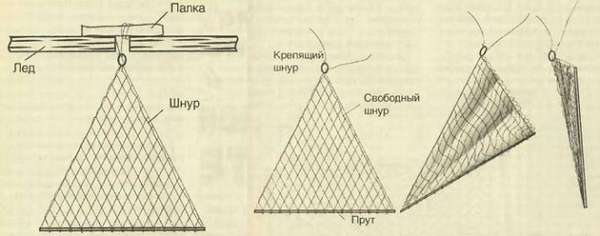
On the fishing rod
Catching live bait with a fishing rod is the standard for winter garrison. You should always have with you a thin tackle with a small jig (or a float and a hook) in order to catch the fry if necessary. The prepared one may spoil or run out, but the fishing rod is in the box - here it is, drill a hole and fish. Sometimes fishing requires larger live bait (especially on the first ice), as well as ruffs, perches or rotans. It is easier to catch such fish with a fishing rod than with a net. You can catch live bait in winter right next to the girders, when there are no openings. A good cure for boredom. Sometimes a predator ignores fish brought with it, but willingly takes local fish caught underfoot. In ponds, the bait for pike should be crucian carp from the same pond. And you can catch small crucian carp with live bait in winter right here with a fishing rod. The situation is the same with reservoirs, where the species composition of fish is represented only by rotan and pike. Catching a largemouth is usually not a problem at all.

It is not always possible to catch live bait with a fishing rod in winter - the bite is affected by both the weather and the internal conditions of the reservoir. Sometimes you need to look for fish, feed them, and, in general, take them seriously. True, perches or roach that are too large can bite. Therefore, you need to use the thinnest gear, small jigs, hooks and nozzles. We need an exact size - usually 8-10 cm. We fish according to all the canons of winter fishing - choosing a place, bait, playing with a jig, etc.
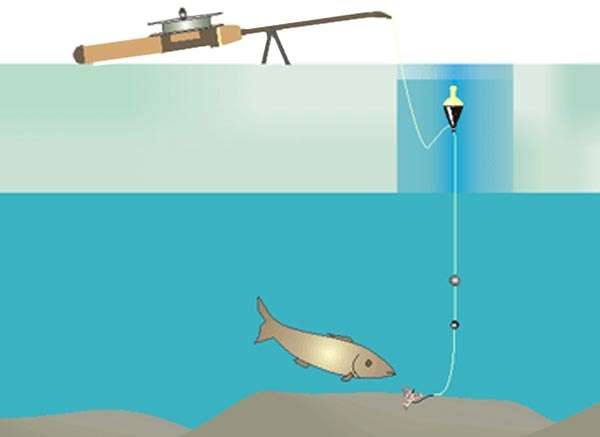
Traps
A healthy alternative is to catch live bait in the winter with traps. The designs of these gears are very diverse and limited by the imagination of fishermen. All of them are made according to the principle of the muzzle (muzzle) or top. Such devices are useful for catching minnows or loaches under the ice. Naturally, measures must be taken to ensure that the live bait trap is positioned correctly on the bottom in the current. You need to put food bloodworms inside. Crucian carp, roach, and other small things go to traps. The easiest way is to make a trap from a five-liter eggplant, and cut the entrances from plastic bottles. A mini trap made from a jar with holes in it will also work. Water passes through the holes and washes out the smell of bait. The attracted small fish swims inside, but cannot get out quickly (due to lack of intelligence), which is what the fisherman takes advantage of.
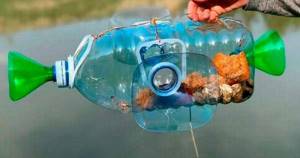
☸ Roach
A classic live bait, advertised in many fishing publications, and therefore quite common. But at the same time ineffective. The roach behaves smartly on the hook, it can be seen from afar, but in most reservoirs it does not bring decent catches. Why is this happening? This can be explained by the fact that this species is more vulnerable than others to tape parasites, and pike, which is the main target of live bait fishing, immediately recognizes infected fish and does not come close to it.
Some fishermen may want to object and give examples from personal experience, they say, they have used roach as live bait more than once and were satisfied with the fishing. No one is saying that this fish is generally not suitable for use as live bait, it’s just that the predator is not caught with it everywhere. A small roach attached to a hook can be catchable only under certain conditions. Namely:
• there are a lot of predatory fish in the reservoir; • he does not experience strong pressure from fishermen; • it is home to tasty and, most importantly, healthy roaches.

And yet, this fish has one undeniable advantage - high activity. When a threat appears, it does not press down to the bottom, does not try to bury itself in the mud or hide in thick grass, but rushes to the surface as far as the leash allows. This behavior cannot go unnoticed by a passing predator. In other words, the roach reveals itself and with its mobility provokes large perch, pike and other “meat eaters” to attack.
As already mentioned, catching live bait in the fall is complicated by the fact that underwater inhabitants move to depth. Roach is no exception. Plus, its bite at this time of year becomes so cautious that sensitive equipment does not always help. Therefore, again, it makes sense to use a lift, which should be lowered beyond the border of the coastal vegetation that has not yet fallen.
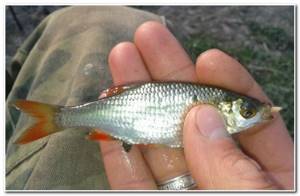
Live bait roach easily adapts to home conditions and is perfectly stored, especially if water aeration is provided in the container. In this regard, there are no problems with her.
Catching perch with live bait
Perch takes fry with great pleasure, so catching perch with live bait is quite popular. The offered bait is well known to him, because in most stagnant and low-flowing reservoirs the main food item for perch is the verkhovka.
No matter how hard manufacturers of spinning baits try to offer a sufficiently effective alternative to the natural prototype, they have not yet succeeded. Sensations from shape, color, smell and vibrations familiar from a very early age help the predator recognize a fake.
You can easily verify this by replacing the fry with a twister or spinner when fishing for perch in the fall.
Confident grip on artificial baits is observed only during periods of increased activity of the predator, and when it is sluggish, indecisive and standing at the bottom, offer it live bait - you can’t go wrong.
Predatory fish will only pay attention to live bait if it is active underwater. While in the bottom layer, the baitfish sitting on the hook must constantly send a vibration signal about its presence.
The predator is extremely reluctant to bite on a weakened, let alone lifelessly hanging fish. After several casts, they find out what physical form the baitfish is in: if the fish takes a natural horizontal position in the water and actively works with its tail fin, everything is in order, you can continue fishing; if the top falls on its side, it must be replaced.
For short fishing you will need 30-40 tops placed in a small canna (3 liters). This amount is usually enough to replace fallen baitfish and to fish several promising places chosen by the fisherman.
The fish is placed on the hook, removing the sting from the nostril, while the tip takes a horizontal position in the water and remains viable longer. You should not stick it by both lips, as this quickly weakens it and hangs motionless on the hook, causing mistrust of a cautious predator.
In case of indecisive and sluggish biting, this technique helps out: carefully, trying not to damage the baitfish’s spine, make a puncture in the area of the dorsal fin. It causes serious concern to the fry, which begins to produce vibrations characteristic of a wounded fish.
“Easy” prey immediately attracts the attention of the phlegmatic predator, and the bite follows immediately. The disadvantage of this method of attaching live bait is that in this case the jig must simply hang in the water column, and it is very problematic to perform an effective stepwise retrieve, because then the bait will move unnaturally, sideways.
The number of escapes increases slightly, as the perch always begins to swallow the victim from the head. The farther the hook is in the mouth, the greater the chance of the angler hooking the fish.
☸ Minnow
Today, live bait is considered to be in short supply due to widespread population decline. The reason for this is uncontrolled fishing for the purpose of sale to live bait fishing enthusiasts. Some reservoirs that were previously abundant with gudgeon have literally been strained out, so one cannot count on a quick restoration of the population. Nowadays, it is rare that anyone manages to find an untouched river or stream in which they can catch at least a few minnows for their own needs.
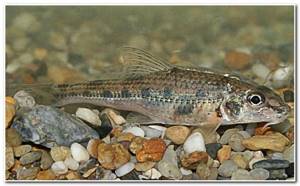
How to catch this fish? The best option is a sensitive fishing rod with a miniature float and delicate equipment. In autumn, river minnows prefer to stay in medium and deep areas with weak currents and silted bottom, so it makes sense to use a boat. It is advisable to harvest live bait on quiet, clear days, when the gudgeon feeds more actively. You can attract a flock with a small amount of chopped worms, and it is preferable to put bloodworms on the hook.
Gudgeon is a very catchy live bait, showing excellent results when fishing with donks and mugs. He is respected not only by toothy predators, but also by asp, pike perch, chub, and perch. It is possible to catch trophy catfish in a channel pit. You can mount the gudgeon any way you like, the main thing is that it passes freely into the mouths of predators, including toothless ones.
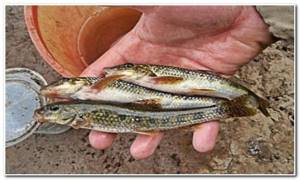
Minnows are stored in cool water, the temperature of which should not be higher than 10 degrees. You can store it in a wide container filled with about 25 cm of water. If you put it in a basement or a cold garage, live bait will live quite a long time, it is possible that they will even last until the first ice.
How to put a fry on a hook, the most unreliable methods.
For example, when it is inserted by one sponge through the nostril or both at once, as well as under the dorsal fin.
With such baiting methods, the fish often flies off the hook. Although the survivability with such methods of placing fry is much better than with all others. The fish will stay on the hook better if you pierce the dorsal fin with the sting of the hook, then turn it and carefully pass it under the fin again. The vitality of the fish, of course, will decrease. But nevertheless, nothing will hinder the movements of the fry, and it will better attract a predator.
There are many other ways to hook a fry. At the same time, the vitality and mobility of the fish decreases in proportion to the increase in hooks and equipment. Therefore, it is better to use one of the old methods, which has been used by more than one generation of fishermen when fishing for whitebait. After baiting the fish using one of the “unreliable” methods described above, a small piece of soft cambric or nipple rubber is put on the hook tip. It will not allow the fish to quickly fly off the hook, will not limit its movements, and at the same time will not at all interfere with the predator’s swallowing.
☸ Perch
Excellent live bait for fishing for pike, pike perch, catfish, eel and... older brothers. When a large perch fails to grab a roach or a verkhovka, it does not hesitate to profit from its smaller relative. Having acquired a taste for it, the striped cannibal begins to purposefully hunt its relatives.

Live bait perch has a unique quality - it feels great both in shallows and at serious depths, which allows it to be used when fishing with a variety of gear. Unlike young roach, silver bream or fisherman, with the arrival of autumn cold, young perch rush to the riverbed depth, where catfish and eel are already waiting for them. In a short period of life (less than a year), they did not have time to gain weight and get stronger, so they are easy prey for deep-sea predators.
We can say that the current carries them straight into the mouth of the monsters lurking at the bottom. Experienced fishermen know this, which is why they prefer to catch trophy pike perch, catfish or eels using one-year-old perches. Diving a perch to a depth of more than 10 meters should be divided into several stages: first lower it to the 5-meter mark, take a short pause, then give another 3 meters, pause again and deliver the live bait to the bottom. This is necessary so that he is not shocked by the rapid descent and continues to behave as naturally as possible.
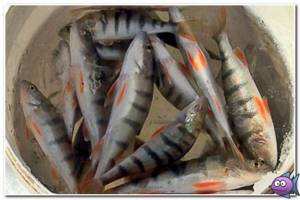
Unfortunately, perch does not live long “in captivity”; it is unlikely to be preserved for several days even with an aerator. Therefore, you need to harvest striped live bait the day before fishing, or even better, catch it on the same day in the same body of water using a regular fly rod.
☸ Ruff
As an object of fishing, this prickly fish is not of particular interest, except perhaps for preparing fish soup in nature. But as a live bait, the ruffe is very good, especially for fishing for burbot in the dark. It is not surprising, because both species are more active at night than during the day, and besides, they are closest neighbors in the reservoir. With the onset of darkness, the ruffe begins to move in search of larvae and other living creatures, and the burbot clearly registers fluctuations in the water and quickly finds it. In mid-autumn, when there are no longer so many fry, the ruffe becomes a desirable prey for pike, pike perch and bersh.

Asp also does not refuse this tasty fish. Sometimes there are moments when the predator does not show itself at all, as they say, neither a bite nor a splash. After unsuccessful experiments with several species of live bait, it begins to seem that there is no bait in the water at all. But once you put a small brush on the hook, everything falls into place. One can only guess why this inconvenient “thorn” attracts predatory fish. Most likely, the reason lies in the excellent taste of the ruff.
As a bait, the ruffe is suitable for fishing with a live bait rod, donka with appropriate equipment and mugs. But first he must be caught. During the day, it is best to do this with the help of a bait donkey, a feeder or a light picker, and at night, when the ruffes feed near the shore, a float rod equipped with a firefly becomes relevant. The bait in both cases is clay mixed with pieces of worms or food bloodworms. The same should be applied to the hooks. Besides clay, of course!
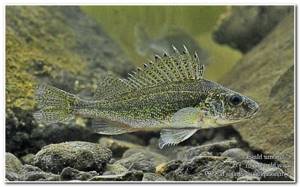
Where and when to fish? It is believed that in the late afternoon this fish leaves the depths and enters the coastal shallows, but it is extremely difficult to guess the locations of such exits. The most annoying thing is that the ruffs, which have been annoying throughout the summer, suddenly disappear somewhere in the fall. When you don’t need them, you don’t have time to take them off the hook, and when the need arises to catch a dozen live bait, the task turns out to be almost impossible. Therefore, persistent fishermen who, after much effort, manage to discover points visited by schools of ruff, do not tell anyone about them.
Storing “prickly bait fish” does not require any special tricks. A capacity of fifty liters, water from a reservoir and a suitable temperature (up to 10 degrees) - these are, in fact, all the components of long-term storage.
How to save live bait
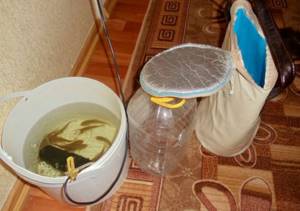
It’s not enough to catch live bait; you also need to preserve it, which is not so easy. This is especially true for winter fishing. If in summer you can catch live bait and immediately put it on a hook, then in winter this option is considered unpromising. So!
How to keep live bait in the summer
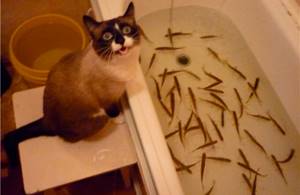
The problem of preserving live bait comes down to providing it with conditions close to natural ones. The main task is to provide the fish with oxygen. As a rule, there is always more oxygen in cold water than in warm water. Therefore, you need to regularly replace warm water with fresh water taken from a reservoir. If live bait is caught directly on a reservoir, then it is enough to place it in a small cage and send it into the water. At the same time, you need to choose the right place. You should not leave live bait in areas exposed to sunlight. Most fish species simply cannot tolerate this.
In other conditions, when long-term storage of live bait is required, it is necessary to provide a special container with an aerator that provides the required level of oxygen in the water.
In case of transportation over a considerable distance, care must be taken to ensure that the water always remains cold. To do this, you can use artificial ice or freeze a bottle of water and place it in a container with live bait.
It should also be remembered that fish do not tolerate temperature changes well. Therefore, there is no need to add water that is too cold. You need to monitor the temperature in the container where the live bait is kept, and try to add water at the same temperature.
How to keep live bait in winter
In winter, it is necessary to ensure that the water in the container where the live bait is stored does not freeze. As it is, there are no special problems, except when it is necessary to ensure long-term storage of live bait. Then the task comes down to saturating the water with oxygen.
How to keep live bait in winter
☸ Rotan
In recent years, this small fish has occupied almost all bodies of water, but it has not yet joined the list of catchable live baits. The low demand for rotan is explained by two reasons: 1) after casting the tackle, it hides in the grass or gets buried in the bottom silt, where it becomes invisible; 2) on many rivers and lakes, predators disdain it, preferring to hunt more familiar fish.
The only tackle that can be effectively combined with rotan live bait is an anchored circle. It provides for a change in descent, allowing you to keep rotan at some distance from life-saving vegetation and bottom soil. Once in an open space, he will be “nervous” and try to reach the nearest shelter and thereby attract the attention of a pike or perch.

Catching a voracious rotan is as easy as shelling pears. This can be done even with a 2-meter stick if you tie a fishing line and a hook to it, but it is better to take a fishing rod with a side nod. This fish does not leave the thickets of coastal vegetation until winter, so it is enough to find a suitable place, lower a jig of any shape into the water and tease the future bait a little. Rotan grabs prey greedily, swallows it deeply and almost never gets off the hook.
There will be no problems with harvesting such live bait, but harvesting rotan for future use is at least unwise. The chances that he will live for at least half a day are very small.
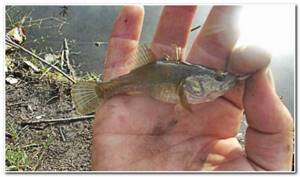
☸ Crucian carp
When talking about catching live bait in the fall, one cannot fail to mention crucian carp. This is a universal live bait that works great against all predators. Fishermen stock up on small crucian carp for several months in advance and do not be afraid that they will fall asleep ahead of schedule. Surprisingly, this fish is able to survive in any conditions. Some avid lovers of live bait fishing have huge barrels in their basements, in which the silver beauties feel like they are at a resort.
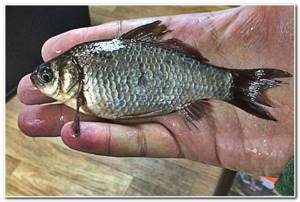
Nowadays you can even buy small crucian carp in fishing stores. Perhaps this is the easiest way to get attractive and catchable baitfish, but it goes against current fishing rules. The fact is that imported live bait is a carrier of infection from one body of water to another, so today it is prohibited. Don't forget about this.
